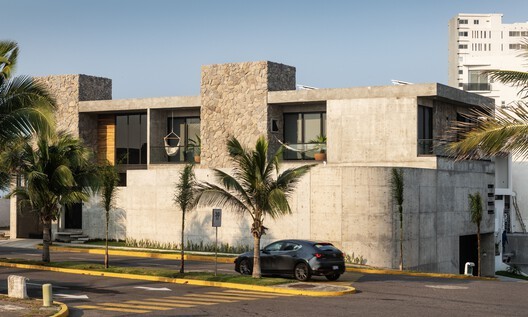#the mandingas
Explore tagged Tumblr posts
Text





#cape verde#carnival culture#sao vincente carnival#the mandingas#mandingas#the mandinga funeral#carnival funeral#mmb
7 notes
·
View notes
Text
#videos#di maria: esto no es nada comparado a lo que me contaban mis abuelos y sus encuentros con mandinga (?#q
185 notes
·
View notes
Text
Black Woman (Mujer Negra) // Nancy Morejón
Still I smell the foam of the sea which they made me cross. The night, I cannot remember it. Not even the ocean itself could remember it. But I do not forget the first gannet I made out. High, the clouds, like innocent eyewitnesses. Perhaps I have not forgotten either my lost coast, or my ancestral tongue. They left me here and here I have lived. And because I worked like a beast, here I was born again, And I sought to rely on epic story of the Mandinga after epic story.
I rebelled.
His Honour bought me in a square, I embroidered His Honour’s coat and gave birth to a son for him. My son had no name And His Honour, he died at the hands of an impeccable English lord.
I walked.
This is the land in which I suffered beatings and floggings. I rowed the length of all its rivers. Under its sun I sowed, I reaped and I did not eat the harvests. For a house I had a shack. I myself brought stones to build it, but I sang to the natural beat of the national birds.
I rose up.
In this same land I touched the humid blood and the rotted bones of many others, brought to it, or not, the same as I. By then I did not imagine the way to Guinea any more. Was it to Guinea? To Benin? Was it to Madagascar? Or to Cape Verde?
I worked much harder.
I laid better foundations for my millennial song and my hope. Here I built my world.
I went off to the mountains.
My real independence was the Palenque and I rode among the troops of Maceo. Only a century later, together with my descendants, from a blue mountain, I came down from the Sierra. to put an end to capitalists and usurers, to generals and the bourgeoisie. Now I am: Only today do we have and create. Nothing is outside our reach. Ours the land. Ours the sea and the sky. Ours magic and the chimera. My equals, here I watch them dance around the tree we planted for communism. Its prodigious wood already resounds.
(translated from the Spanish by Jean Andrews)
#poetry#Nancy Morejón#Jean Andrews#Cuban poetry#Afro-Cuban poetry#Black American poetry#Spanish poetry#resistance#Resistencia#poems of protest#poems of praise#Mandinga#palenque#communism#anti-capitalism#revolutionary poetry#revolution#the sea
3 notes
·
View notes
Photo
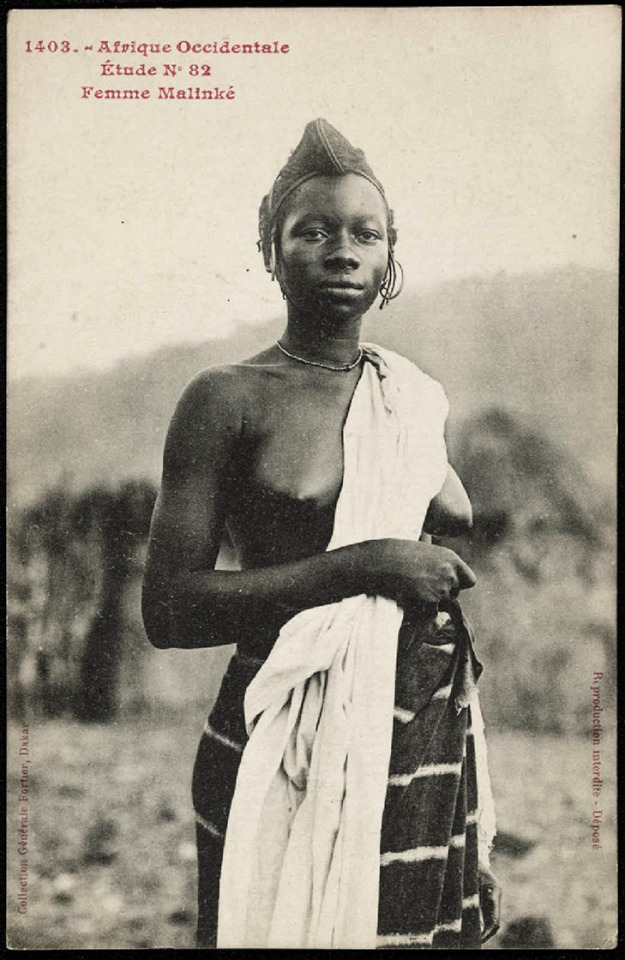
mulher mandinga, áfrica ocidental, edmond fortier.
7 notes
·
View notes
Photo



Mandinga Rose Top
Worn with: Celine trousers, Gucci bag
| Attending Dr Barbara Sturm dinner in New York, November 1st 2022 |
2 notes
·
View notes
Text
Macabre Month 7 Part VI: Transylmania (2009)
In today's review, I get schooling in the heart of Transylvania, as I attempt a #positive review of the 2009 vampire comedy Translymania #PatrickCavanaugh #TonyDenman #PaulHKim #JenniferLyons #OrenSkoog #DavidSteinberg #MusettaVander #IrenaAHoffman
While origins have been told and retold, the modern vampire has been around for centuries. One would think we are all out of ideas, that there is no way to redo what already has come before and what audiences are familiar with and come to expect. Yet, with exception, it can come with subversion. In 2009, to bring a fresh spin on Dracula and his kin, a group of college students headed to the…
#2009#Adriana Butoi#Ali Adawiya#Ashley Barron#Bonnie Morgan#Brett Gipson#Carey Embry#Claudiu Trandafir#Colin Campbell#comedy#David Steinberg#Désirée Malonga#Elena-Cristina Marchisano#film#films#horror#Irena A. Hoffman#James DeBello#Jennifer Lyons#Jessica Mei Gershen#Jonathan Perkins#Kommerina DeYoung#macabre month#Mandinga#Movies#Musetta Vander#Natalie Garza#Nicole Garza#Oren Skoog#Patrick Casey
1 note
·
View note
Text
Румынские участники Евровидения 2012: Устроим в Baku Crystal Hall танцевальный флешмоб
Мы очень ждем своего выхода на сцену в полуфинале «Евровидения 2012, сказали на пресс-конференции в Баку участники группы Mandinga, которая представит Румынию на «Евровидении 2012». Выступление группы состоится в первом полуфинале «Евровидения 2012» под номером 6. На пресс-конференции группа появилась в полном творческом составе, включая солистку и танцоров, а также представителей делегации Румынии на «Евровидении 2012». «Ждем от «Евровидения 2012» многого, так как очень верим в свою конкурсну... Читать дальше »
0 notes
Text
La última gran rebelión de esclavos negros en la región azucarera de Veracruz
#DeOficio #Histórico Textos para enriquecer el conocimiento sobre la negritud en #Veracruz | Chécalo | Suscríbete | A su consideración
Eric Taladoire | En 1735, una rebelión de esclavos estalló en la Hacienda Nuestra Señora de la Concepción, cerca de San Juan de la Punta, Veracruz. Una tropa de 500 rebeldes, entre ellos el esclavo Fernando Manuel, mató al personal y a los capataces de la hacienda antes de huir hacia la sierra vecina. Mantuvieron allí durante más de 30 años una resistencia testaruda, y toda la región de Córdoba…
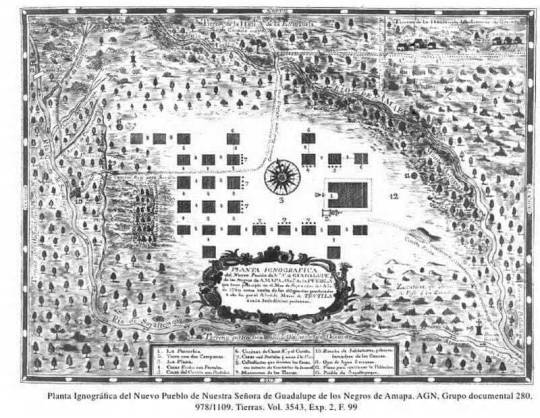
View On WordPress
0 notes
Text
Dostrescinco & Caliope Family traen el hip hop a Sala del Museo
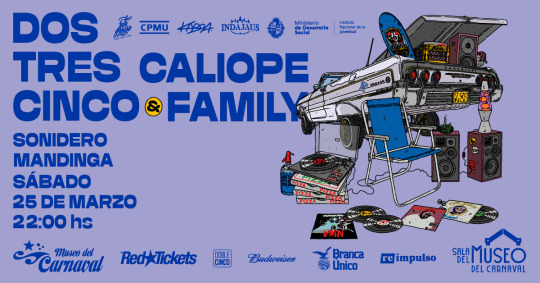
Este 25 de marzo Dostrescinco y Caliope Family llegan a la Sala del Museo, con musicalización a cargo de Sonidero Mandinga y la promesa de una velada a puro hip hop rioplatense.

No es la primera vez que rosarinos y montevideanos se encuentran en el escenario; la dupla viene de probarse exitosa con una fecha en la capital porteña el pasado 4 de febrero, calentando motores para encontrarse esta vez en suelo uruguayo. Con una esencia que los hermana, bases de ritmo sólido y barras poderosas, ambas bandas prometen para este show una noche de goce con la musicalización del Dj local Sonidero Mandinga.
youtube
Dostrescinco es — hace años — un nombre referente del hip hop en nuestro país. Con la guía de Gabino Suanes, Bruno Cammá y Taio, esta nueva etapa de la banda (que volvió a los escenarios en 2021 después de un descanso pre-pandémico) continúa con la línea de groove, soul y funk que caracteriza al grupo. En vivo los acompaña una banda completa que aporta la versatilidad necesaria para poner al público a bailar con sus rimas.
Dostrescinco viene de de llevarse otro Premio Graffiti a casa, esta vez el de Mejor Single de Música Urbana por Nuestra Huella (ft. Emiliano Brancciari) y recientemente adelantaron su próximo álbum con el corte Reír Así.
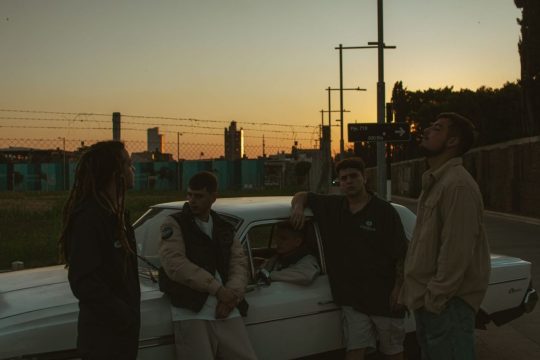
Caliope Family es un proyecto liderado por Brapis, MC rosarino de más de 10 años de trayectoria. Con sonidos que van desde el jazz a los beats más tradicionales de la música urbana, el grupo tiene una fuerte impronta musical, seguramente heredada del pasado de sus integrantes (todos tocaron en distintas bandas antes de formar Caliope Family, lo que les brinda un antecedente compositivo más instrumental). La sonoridad del quinteto se luce tanto en vivo como en sus dos trabajos de estudio: Rythms and Rhymes (2018) y Chainz (2020), este último con aún más fusión y experimentación entre géneros.
En enero dieron inicio al 2023 con el single Da Funk, una apuesta fuerte a nivel de producción musical y audiovisual que anticipa un nuevo disco en camino. Llegan a Montevideo después de presentarse en Córdoba como parte del lineup del Cosquín Rock, donde hicieron bailar a las masas bajo el sol de las sierras.
youtube
Dostrescinco y Caliope Family se presentan en próximo 25 de marzo en Sala del Museo. La primera tanda de entradas ya puede adquirirse a través de RedTickets y tiene un costo de $570. El show es apto para mayores de 18 años, comienza a las 22 y continúa después de las bandas al ritmo de Dj Sonidero Mandinga. Una noche imperdible de groove rioplatense.
#agenda#dostrescinco#caliope family#sonidero mandinga#rap#hip hop#uruguay#sala del museo#ardeportal#montevideo#rosario
0 notes
Text

Cape Verdean Mandinga Warrior, Cape Verde, by Mario Soares
#cape verdean#cape verde#africa#western africa#folk clothing#traditional clothing#traditional fashion#cultural clothing
253 notes
·
View notes
Text
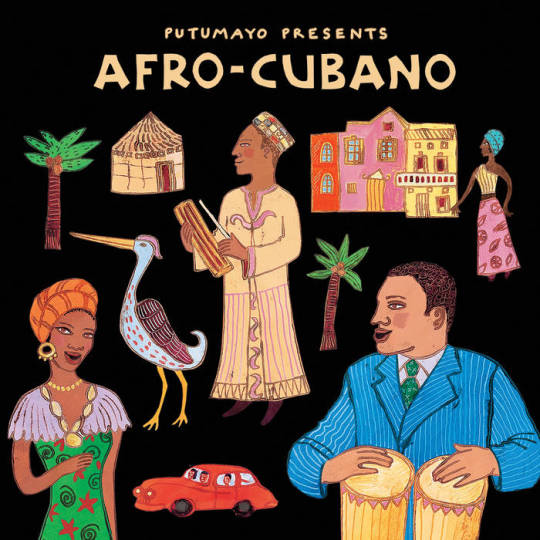
Music of African heritage in Cuba derives from the musical traditions of the many ethnic groups from different parts of West and Central Africa that were brought to Cuba as slaves between the 16th and 19th centuries. Members of some of these groups formed their own ethnic associations or cabildos, in which cultural traditions were conserved, including musical ones. Music of African heritage, along with considerable Iberian (Spanish) musical elements, forms the fulcrum of Cuban music.
Much of this music is associated with traditional African religion – Lucumi, Palo, and others – and preserves the languages formerly used in the African homelands. The music is passed on by oral tradition and is often performed in private gatherings difficult for outsiders to access. Lacking melodic instruments, the music instead features polyrhythmic percussion, voice (call-and-response), and dance. As with other musically renowned New World nations such as the United States, Brazil and Jamaica, Cuban music represents a profound African musical heritage.

Clearly, the origin of African groups in Cuba is due to the island's long history of slavery. Compared to the USA, slavery started in Cuba much earlier and continued for decades afterwards. Cuba was the last country in the Americas to abolish the importation of slaves, and the second last to free the slaves. In 1807 the British Parliament outlawed slavery, and from then on the British Navy acted to intercept Portuguese and Spanish slave ships. By 1860 the trade with Cuba was almost extinguished; the last slave ship to Cuba was in 1873. The abolition of slavery was announced by the Spanish Crown in 1880, and put into effect in 1886. Two years later, Brazil abolished slavery.
Although the exact number of slaves from each African culture will never be known, most came from one of these groups, which are listed in rough order of their cultural impact in Cuba:
The Congolese from the Congo Basin and SW Africa. Many ethnic groups were involved, all called Congos in Cuba. Their religion is called Palo. Probably the most numerous group, with a huge influence on Cuban music.
The Oyó or Yoruba from modern Nigeria, known in Cuba as Lucumí. Their religion is known as Regla de Ocha (roughly, 'the way of the spirits') and its syncretic version is known as Santería. Culturally of great significance.
The Kalabars from the Southeastern part of Nigeria and also in some part of Cameroon, whom were taken from the Bight of Biafra. These sub Igbo and Ijaw groups are known in Cuba as Carabali,and their religious organization as Abakuá. The street name for them in Cuba was Ñáñigos.
The Dahomey, from Benin. They were the Fon, known as Arará in Cuba. The Dahomeys were a powerful group who practised human sacrifice and slavery long before Europeans arrived, and allegedly even more so during the Atlantic slave trade.
Haiti immigrants to Cuba arrived at various times up to the present day. Leaving aside the French, who also came, the Africans from Haiti were a mixture of groups who usually spoke creolized French: and religion was known as vodú.
From part of modern Liberia and Côte d'Ivoire came the Gangá.
Senegambian people (Senegal, the Gambia), but including many brought from Sudan by the Arab slavers, were known by a catch-all word: Mandinga. The famous musical phrase Kikiribu Mandinga! refers to them.
Subsequent organization
The roots of most Afro-Cuban musical forms lie in the cabildos, self-organized social clubs for the African slaves, and separate cabildos for separate cultures. The cabildos were formed mainly from four groups: the Yoruba (the Lucumi in Cuba); the Congolese (Palo in Cuba); Dahomey (the Fon or Arará). Other cultures were undoubtedly present, more even than listed above, but in smaller numbers, and they did not leave such a distinctive presence.
Cabildos preserved African cultural traditions, even after the abolition of slavery in 1886. At the same time, African religions were transmitted from generation to generation throughout Cuba, Haiti, other islands and Brazil. These religions, which had a similar but not identical structure, were known as Lucumi or Regla de Ocha if they derived from the Yoruba, Palo from Central Africa, Vodú from Haiti, and so on. The term Santería was first introduced to account for the way African spirits were joined to Catholic saints, especially by people who were both baptized and initiated, and so were genuine members of both groups. Outsiders picked up the word and have tended to use it somewhat indiscriminately. It has become a kind of catch-all word, rather like salsa in music.
The ñáñigos in Cuba or Carabali in their secret Abakuá societies, were one of the most terrifying groups; even other blacks were afraid of them:
Girl, don't tell me about the ñáñigos! They were bad. The carabali was evil down to his guts. And the ñáñigos from back in the day when I was a chick, weren't like the ones today... they kept their secret, like in Africa.

African sacred music in Cuba
All these African cultures had musical traditions, which survive erratically to the present day, not always in detail, but in the general style. The best preserved are the African polytheistic religions, where, in Cuba at least, the instruments, the language, the chants, the dances and their interpretations are quite well preserved. In few or no other American countries are the religious ceremonies conducted in the old language(s) of Africa, as they are at least in Lucumí ceremonies, though of course, back in Africa the language has moved on. What unifies all genuine forms of African music is the unity of polyrhythmic percussion, voice (call-and-response) and dance in well-defined social settings, and the absence of melodic instruments of an Arabic or European kind.
Not until after the Second World War do we find detailed printed descriptions or recordings of African sacred music in Cuba. Inside the cults, music, song, dance and ceremony were (and still are) learnt by heart by means of demonstration, including such ceremonial procedures conducted in an African language. The experiences were private to the initiated, until the work of the ethnologist Fernando Ortíz, who devoted a large part of his life to investigating the influence of African culture in Cuba. The first detailed transcription of percussion, song and chants are to be found in his great works.
There are now many recordings offering a selection of pieces in praise of, or prayers to, the orishas. Much of the ceremonial procedures are still hidden from the eyes of outsiders, though some descriptions in words exist.
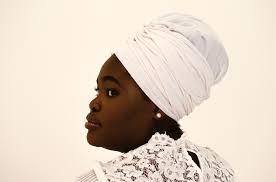
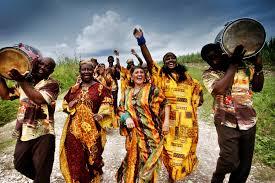
Yoruba and Congolese rituals
Main articles: Yoruba people, Lucumi religion, Kongo people, Palo (religion), and Batá
Religious traditions of African origin have survived in Cuba, and are the basis of ritual music, song and dance quite distinct from the secular music and dance. The religion of Yoruban origin is known as Lucumí or Regla de Ocha; the religion of Congolese origin is known as Palo, as in palos del monte.[11] There are also, in the Oriente region, forms of Haitian ritual together with its own instruments and music.
In Lucumi ceremonies, consecrated batá drums are played at ceremonies, and gourd ensembles called abwe. In the 1950s, a collection of Havana-area batá drummers called Santero helped bring Lucumí styles into mainstream Cuban music, while artists like Mezcla, with the lucumí singer Lázaro Ros, melded the style with other forms, including zouk.
The Congo cabildo uses yuka drums, as well as gallos (a form of song contest), makuta and mani dances. The latter is related to the Brazilian martial dance capoeira
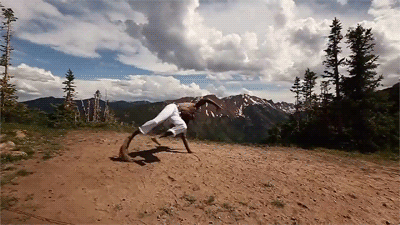
#african#afrakan#kemetic dreams#africans#brownskin#brown skin#afrakans#african culture#fitness#afrakan spirituality#afro cuban music#afro cuban#igbo#yoruba#congo#african music
188 notes
·
View notes
Text
EUREVISION ROUND THREE: ROMANIAN HOUSE
When it's house music... from Romania! Get your southern Slavic/Balkan party mix right tonight.
Our selections are: "Bun Ramas," by DJ Project & Adela Popescu
"Like A Star," by Fly Project
"Back to Me," by Vanotek feat. Eneli
"Rampampam," by Minelli
"Stereo Love," by Edward Maya & Vika Jigulina
"So High," by David Deejay
"Inima Mea," by Crush+Alexandra
"Zaleilah," by Mandinga
"Teach Me," by Claudio Cristo and Tamy
"Fiesta," by Emil Lassaria and Caitlyn
Polls will close, in spite of what the poll duration says, on Wednesday evening.
#romanian house#poll post#i'm honestly surprised at the number of entries. i did have to narrow it down!#that's GOOD btw
51 notes
·
View notes
Text
Mandinga do alfaiate: O que está abaixo da pele, sobe, é de fora e não levanta, caia; se costura e não prende, entre, se me rasga e não cura, saia.
#pequenosescritores#projetoflorejo#projetoalmaflorida#quandoelasorriu#mardeescritos#projetocartel#caligraficou#projetoverboador#carteldapoesia#projetovelhopoema#projetoversografando#pequenosversos#arquivopoetico#espalhepoesias#lardepoetas#liberdadeliteraria#mentesexpostas#poecitas#eglogas#projetosonhantes#autorias#clubepoetico#conhecencia#sonhandoseusonho#fumantedealmas#humverso#projetocores#julietario#poetaslivres#projetoconsolidar
31 notes
·
View notes
Text
Hoy soy el video de "mardito Chávez, mardito Chávez, retrimardito, morite otra vez mardito, pasá más abajo del mardito infierno, pal núcleo, pal mardito centro de la tierra tenéis que estar ahí, con er diablo, con satanás, con lucifer, con belcebú, con mandinga, con el mardito demonio de todos los marditos demonios, mardito hijo de puta"
15 notes
·
View notes
Text
sissoko is a virtuoso of the kora, a traditional string instrument of the West African savannah. Their music fuses traditional Mandinga music with contemporary influences through kora.
10 notes
·
View notes
